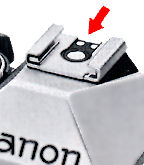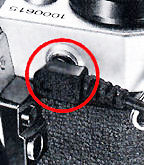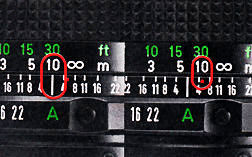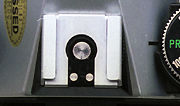22. Flash Photography
 |
Display Information in AE Flash Photography: |
When the Speedlite is charged and the shutter button is pressed halfway, a green
Note: There are more info available at the Canon A-1 Flash section.
Note: 1. Except when the shutter speed selector dial is set to "B", the AE- 1 PROGRAM automatically switches to 1/60 sec. as soon as the Speedlite's pilot lamp and the green |
|
 |
Auto-exposure Flash Confirmation Signal (During its introduction, it works with the Speedlite 188A and 166A only, but other similar dedicated speedlites like the 299A or the TTL's 300TL should works (TTL mode is not possible). Please check with your local Canon Distributor for the compatibility listing. |
After the shutter is released, continue to press the shutter button halfway; the green
 |
 |
 |
Various
Canon |
Note: The auto-exposure
confirmation signal displayed in the viewfinder is for use with the Speedlite 188A
and 166A (or similar dedicated flash units). When using other flash units, the ![]() may
flash on and off after the shutter is released. In such cases, however, it does not
confirm auto-exposure and should be disregarded.
may
flash on and off after the shutter is released. In such cases, however, it does not
confirm auto-exposure and should be disregarded.
The AE-1 PROGRAM
has two flash terminals.
 |
 |
1. Insert a direct-contact hot-shoe type flash directly in the accessory shoe. For this type of flash, no other connection is necessary. |
Note: |
1) Automatic Flash (with Ordinary Electronic Computer Flash Units)
1. Turn the AE-1 PROGRAM's shutter speed selector dial to 1/60 second.
2. Remove the aperture ring of an FD lens from "A" and turn it to the automatic aperture which you have set on the flash.
Note: For more details and compatibility issues, see the instructions for the respective flash you purchased.
2) Manual Flash a. Set the shutter speed selector dial according to the information in the table below:
| Type / Synchronized Shutter Speed(s) |
1/1000 |
1/500 |
1/250 |
1/125 |
1/60 |
1/30 |
1/15 |
1/8 |
1/4 |
1/2 |
1 sec |
2 sec |
B |
|
| Flash Bulbs | FP Class |
|
|
|
|
|
<> |
O |
O |
O |
O |
O |
O |
O |
| M & MF Class |
|
|
|
|
|
<> |
O |
O |
O |
O |
O |
O |
O |
|
| Electronic Flash |
|
|
|
|
O |
O |
O |
O |
O |
O |
O |
O |
O |
|
O = okay
<> = possible un-evenness in picture depending on bulb
b. Calculate the.aperture with a guide-number formula or with the flash unit's calculator dial if it has one. Turn the lens' aperture ring to that aperture.
Some earlier Canon Speedlites 011A, 155A, 166A, 177A, 188A, 199A, 533G and 577G
Instruction Manuals preprared by Mr Christian Rollinger: Canon Flash models:- Canon 300TL flash(1.5MB); Macrolite ML-1(HTML); Macrolite ML-2; Macrolite ML-3; Speedlite 133a; Speedlite 155a(HTML); Speedlite 177a; Speedlite 188a(HTML); Speedlite 199a; Speedlite 244t; Speedlite 277t (HTML); Speedlite 533; Speedlite 577
For the easiest possible flash photography with the AE-1 PROGRAM, Canon offers nine Speedlites. With an FD lens set to the "A" mark, the shutter speed switches to 1/60 sec. and the aperture to the auto aperture set on the flash automatically when the pilot lamp glows. After shutter release, the camera switches automatically to normal AE photography until the pilot lamp glows again. Canon's most powerful Speedlites, the 533G and 577G each use a quick-release grip and a separate sensor which, seated in the camera's accessory shoe, ensures correct exposure even when the flash head is tilted or swung. The A-series Speedlites slide directly into the accessory shoe.
 |
 |
 |
 |
 |
 |
 |
|
Some technical information relating to earlier Canon Speedlites |
||||||||
|
Features/ Speedlites |
011A |
155A |
166A |
177A |
188A |
199A |
533G |
577G |
| Guide Number |
14
(ISO/ASA |
17
(ISO/ASA |
20
(ISO/ASA |
25
(ISO/ASA |
25
(ISO/ASA |
30
(ISO/ASA |
36
(ISO/ASA |
48
(ISO/ASA |
| Min. Usable Lens Focal Length |
35mm |
35mm |
35mm |
35mm; 28mm with Wide Adapter |
35mm; 28mm with Wide Adapter |
35mm; 24mm with Wide Adapter |
35mm; 24mm and 20mm with Wide Adapter |
35mm; 24mm and 20mm with Wide Adapter |
| Max # of Auto Apertures (Differs with ISO/ASA) |
1 |
2 |
2 |
2 |
2 |
3 |
3 |
3 |
| Auto Shooting Dist. Range, Min. to Max. (Differs with Auto Aperture) |
0.5
- 7m |
0.5
- 6m |
0.5
- 7m |
0.5 - 9m 1.6 -30 ft. less with Wde Adapter |
0.5 - 9m 1.6 -30 ft. less with Wde Adapter |
0.5 - 10.6m 1.5 - 35ft. less with Wde Adapter |
1 - 12.8m 3.3 - 42 ft more with Tele Adapter less with Wde Adapter |
1 - 17m 3.3 - 56ft. more with Tele Adapter less with Wde Adapter |
| Bounce |
No |
No |
No |
No |
No |
Yes |
Yes |
Yes |
| Manual Flash |
No |
Yes |
Yes |
Yes |
Yes |
Yes |
No |
Yes |
 |
When using any of these Speedlites, a green LED display lights up in the viewfinder of the AE-1 PROGRAM the moment the flash unit is charged. And, when using the Speedlite 188A or 166A, that same LED display will flash on and off for two seconds after you take a picture to confirm correct exposure. No other flash units offer these features. You can also switch to manual fiash photography with six out of these eight Speedlites. When you are finished using the flash, you can shoot normally while the flash or sensor is still mounted simply by turning off the flash unit's main switch. With seven units available, you have a wide range of features to choose from. The table below lists some of the most important elements for consideration. |
When you load the AE-1 PROGRAM with black and-white infrared film, it is necessary to make a slight adjustment in focus. A red infrared index is engraved on most Canon lenses for this purpose First focus as usual through the viewfinder.
 |
Then read the distance opposite the distance index on the lens and turn the focusing ring to align that distance with the infrared index. It will also be necessary to use a deep red filter, as specified by the film manufacturer, over the lens. |
25. Shooting in Very Low Temperatures |
Try to remember the following:
1. Load a new battery, and keep the camera warm until you are ready to shoot. Try to finish the shooting session as quickly as possible. If you must shoot for a long time, carry a spare battery. Alternate the two batteries, keeping the one that is not in use warm. Do not throw the original battery away. That it does not perform well in the cold does not necessarily mean that it will not work normally again in warmer temperatures. An optional accessory, the Canon External Battery Pack A, is the most reliable power source for uninterrupted shooting in cold weather. 2. Condensation forming on a camera and lens taken from cold outside temperatures into a warm room may cause corrosion. To avoid this, while still outdoors place the camera in a plastic bag. Then seal the bag and take it indoors. Leave the camera in the bag until it gradually reaches room temperature. Generally, this takes about one-half hour.
Shooting at Night
In very dim lighting, such as at night, it may be necessary to make an exposure longer than the slowest shutter speed of two seconds. This is what the "B'! setting of the shutter speed selector dial is for. When you use this setting, the shutter will remain open as long as you press the shutter button.
 |
AE photography is not possible; switch to manual override. With the lens off the "A" setting, an "M" will light up in the viewfinder when you take a meter reading. |
The "B" setting is useful whenever it is too dark for metering. It is also the best way to record several bursts of fireworks on a single frame.
Note:
1. The AE-1 PROGRAM's meter will not give a reading at the "B" setting. You will have to experiment to find the best combination of ~ aperture and exposure duration.
2. Always use a tripod and cable release, preferably lockable, for time exposures, and remember that the camera uses more battery power on the "B" setting. We suggest carrying a spare battery as a safeguard.
| Previous | Next | Focusing Screens and accessories
 Part
I: Basic Camera Operations (3 parts)
Part
I: Basic Camera Operations (3 parts)Part II: Advance Camera Operations (5 parts)
Part III: Other Issues (2 parts)
| Back | The Index page of Canon AE-1 Program
| Back | Main Index Page of Canon SLR Models
| Message Board |
for your Canon
A-Series SLR camera(s)
| Message Board | for your Canon optics
in a shared environment
| Message Board | Specifically for Dispose or Looking for Canon Photographic
Equipment
Shared Resources:
Winder A, Winder A2, Focusing Screens, Motor Drive MA, Databack A,
Speedlites & Macro photography.
Highly suggestive useful external links/resources created by Mr.Christian Rollinger:
Essentials: - Canon AE-1 Program:- A
Repair Manual
B Part List C
General Repair Guide
Canon Flash models:- Canon 300TL flash(1.5MB); Macrolite ML-1(HTML); Macrolite ML-2;
Macrolite ML-3; Speedlite 133a; Speedlite 155a(HTML); Speedlite 177a; Speedlite 188a(HTML); Speedlite 199a; Speedlite 244t; Speedlite 277t (HTML); Speedlite
533; Speedlite 577
Others:- Canon Auto Bellow Unit Manual; Canon Macro Photography Guide, Canon Slide Duplicator Manual, Canon Angle Finder User's Manual
Canon FD Resources
A Series:
AE-1
| AT-1
| A-1 | AV-1
| AE-1 Program | AL-1
T- Series: T50
| T60
| T70
| T80
| T90
F-1
| New F-1
Canon FL
Resources
Pellix
| FTQL
FL | Canon FDn lenses. | Early versions of FD lenses
Canon
EOS SLRs | Canon EF lens Resources
Home - Photography in Malaysia |
Copyright © 2000. leofoo ®. MIR Web Development Team.
Maintenance Team: Kaipin, Terry Carraway & Dr Strangelove; Pawel Nabe for his image on the Data Memory Back. EEwyn Foo, my nephew, who has spent quite a number of nights converting the original manual in HTML format. Mr. Richard Yeow, General Manager -Optical Division of Canon Marketing for granting special permission to reproduce this manual into HTML format in his site as a form of obligation to all Canon FD mount users worldwide. * Canon, FD, FL Lenses, are registered trade names or trademarks of Canon Inc. Japan.
